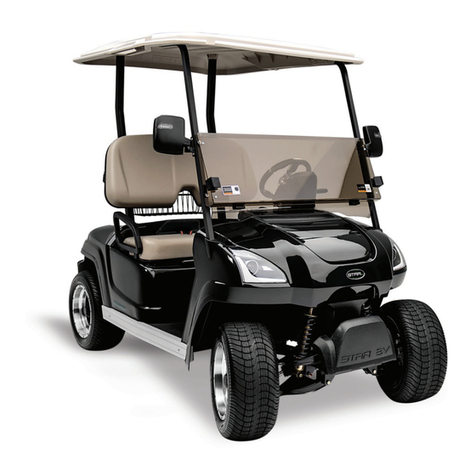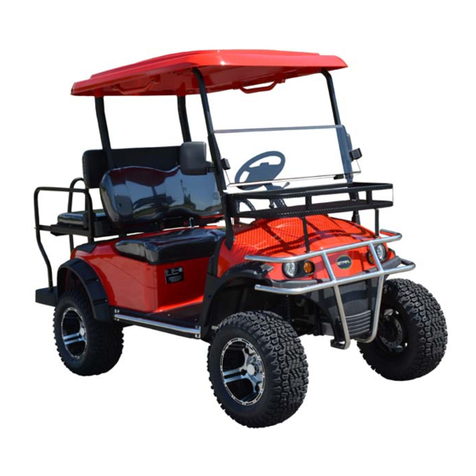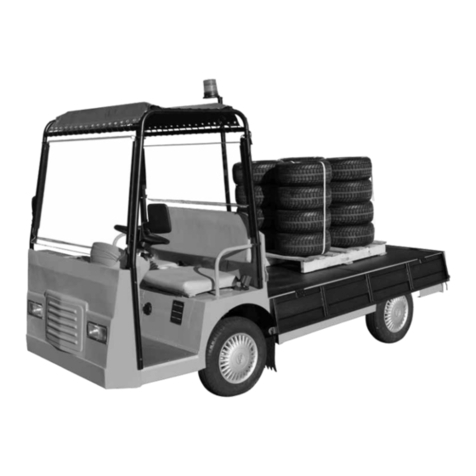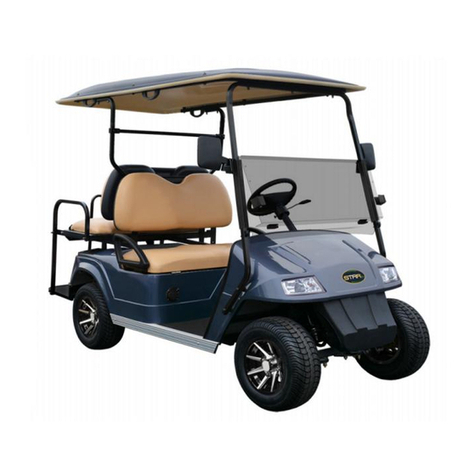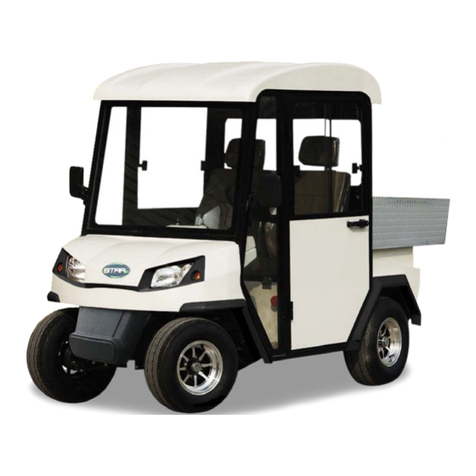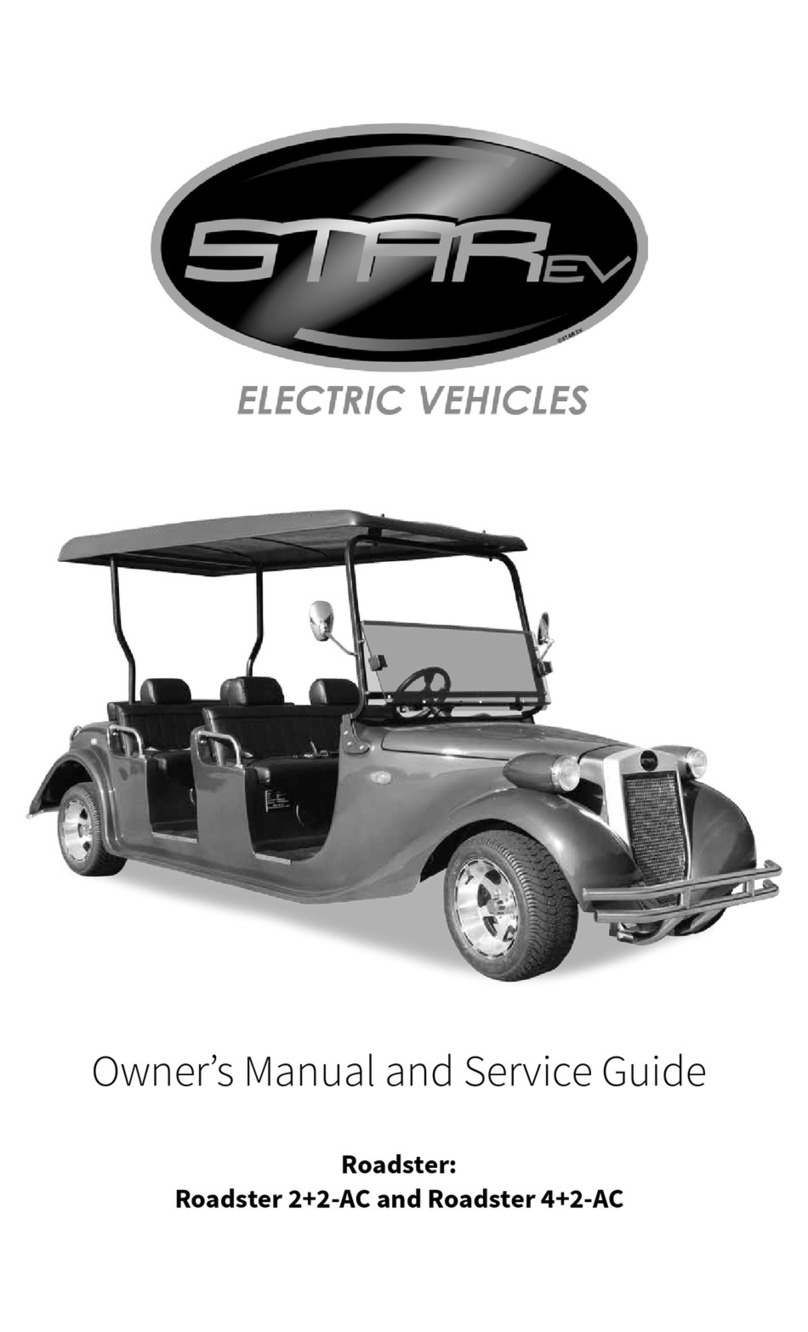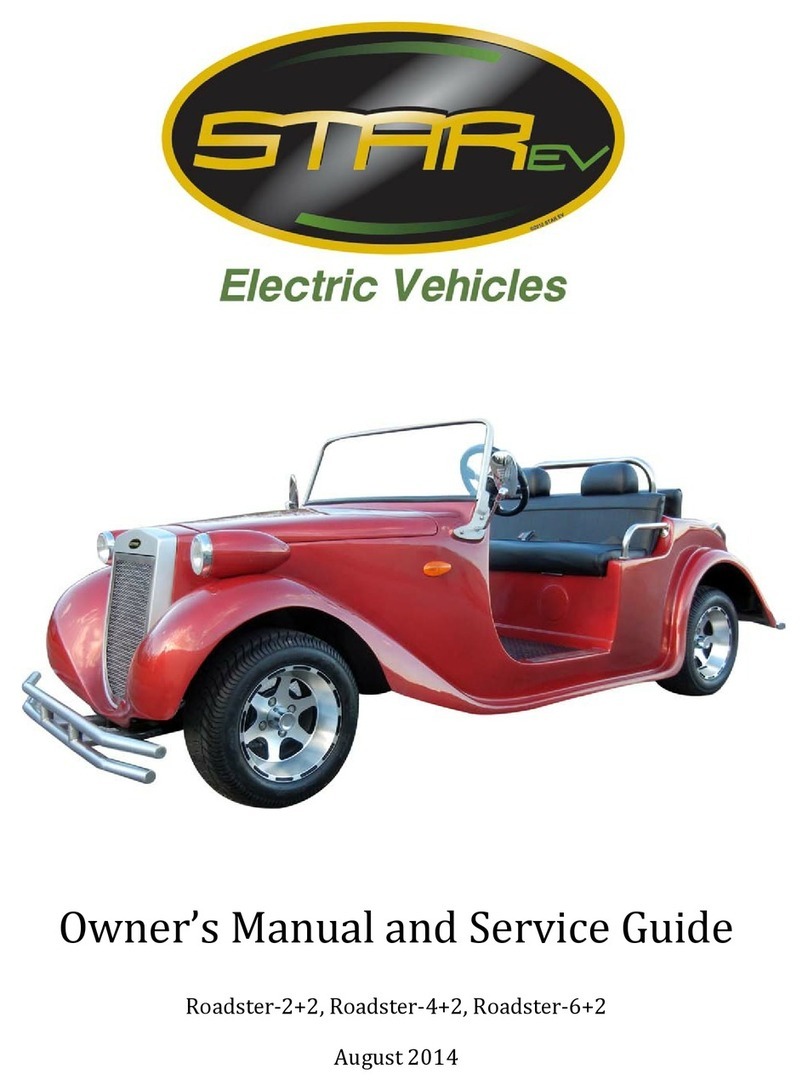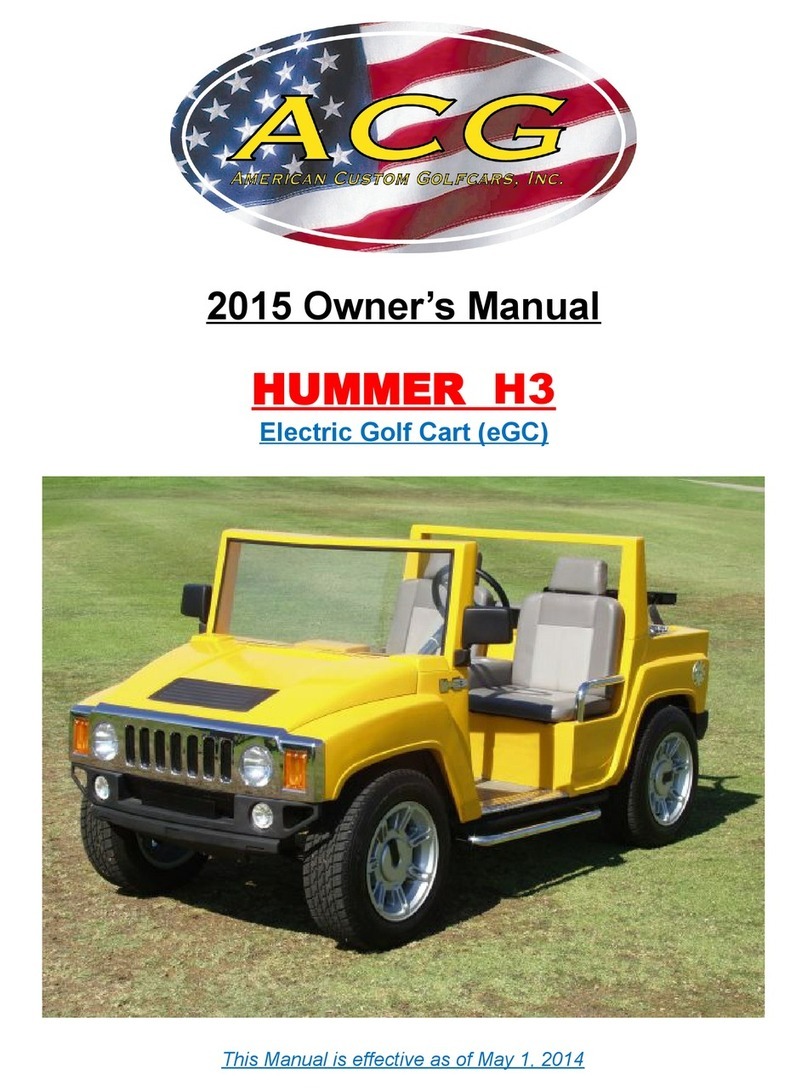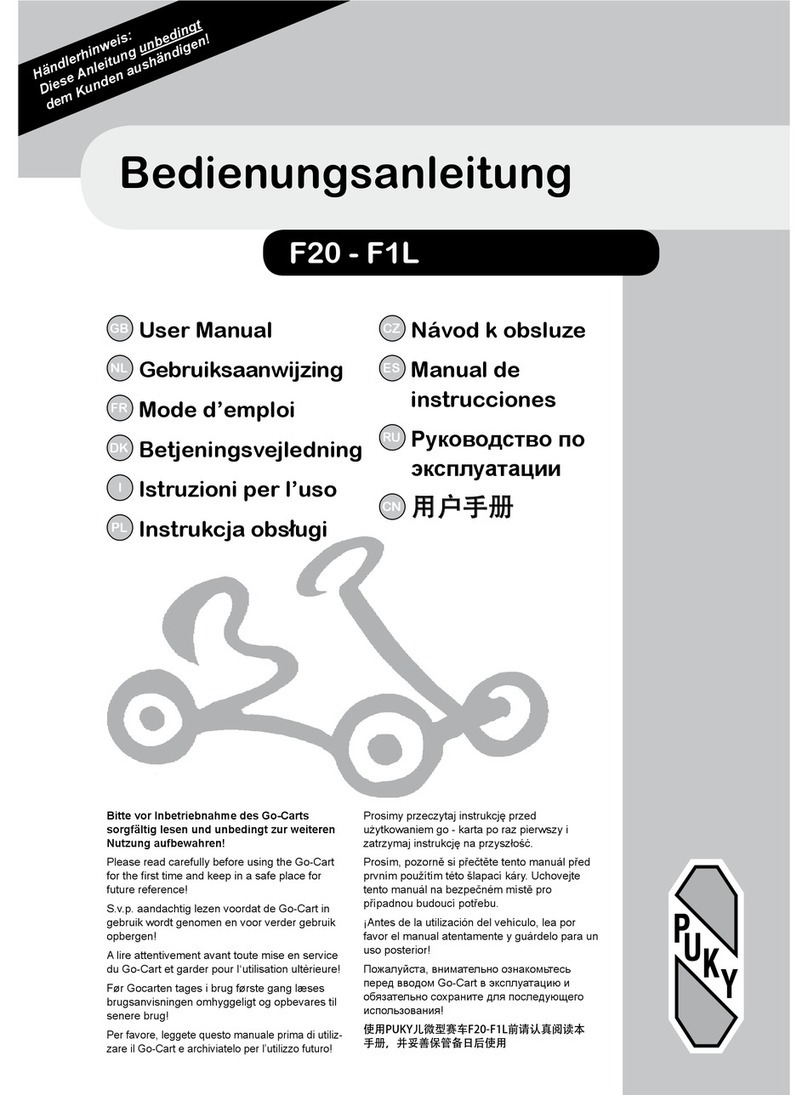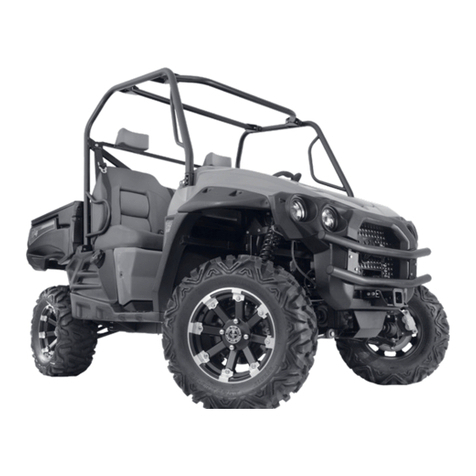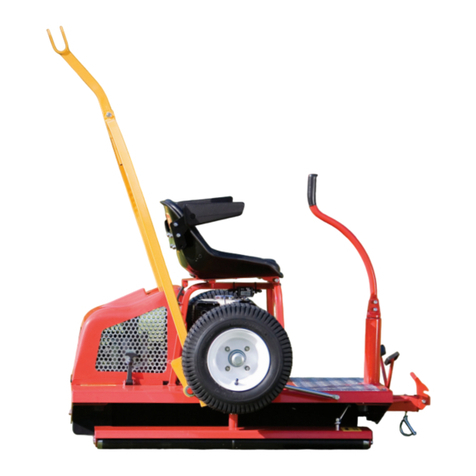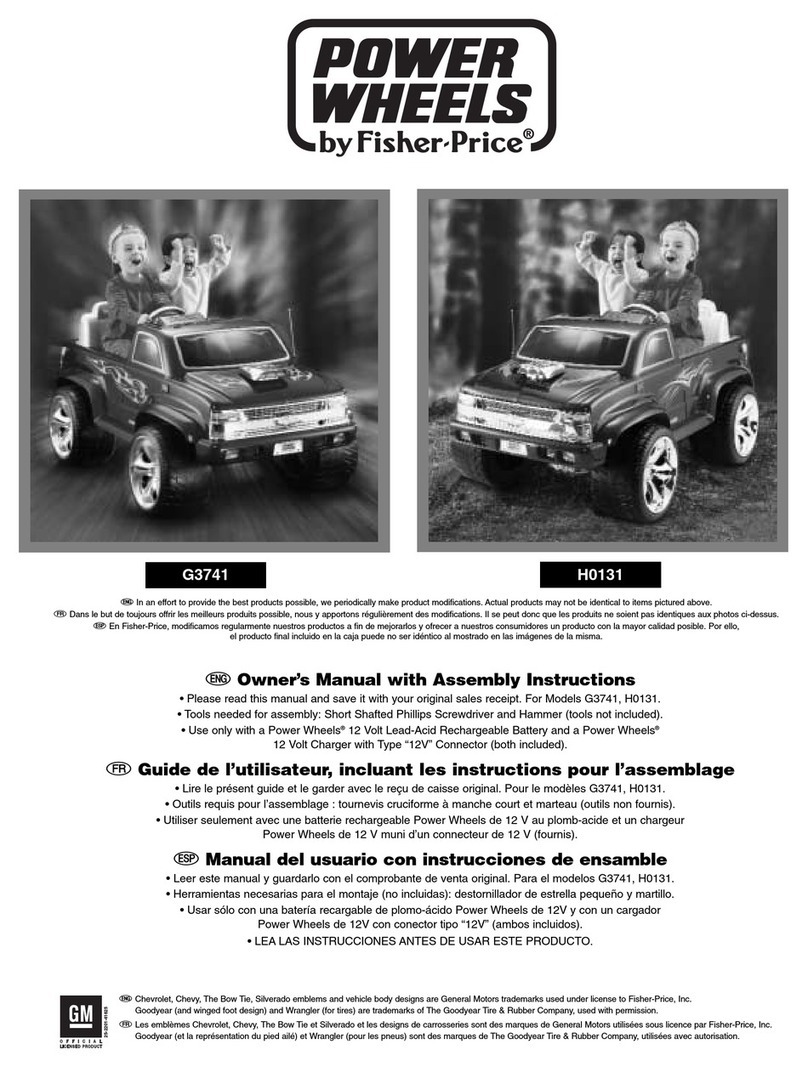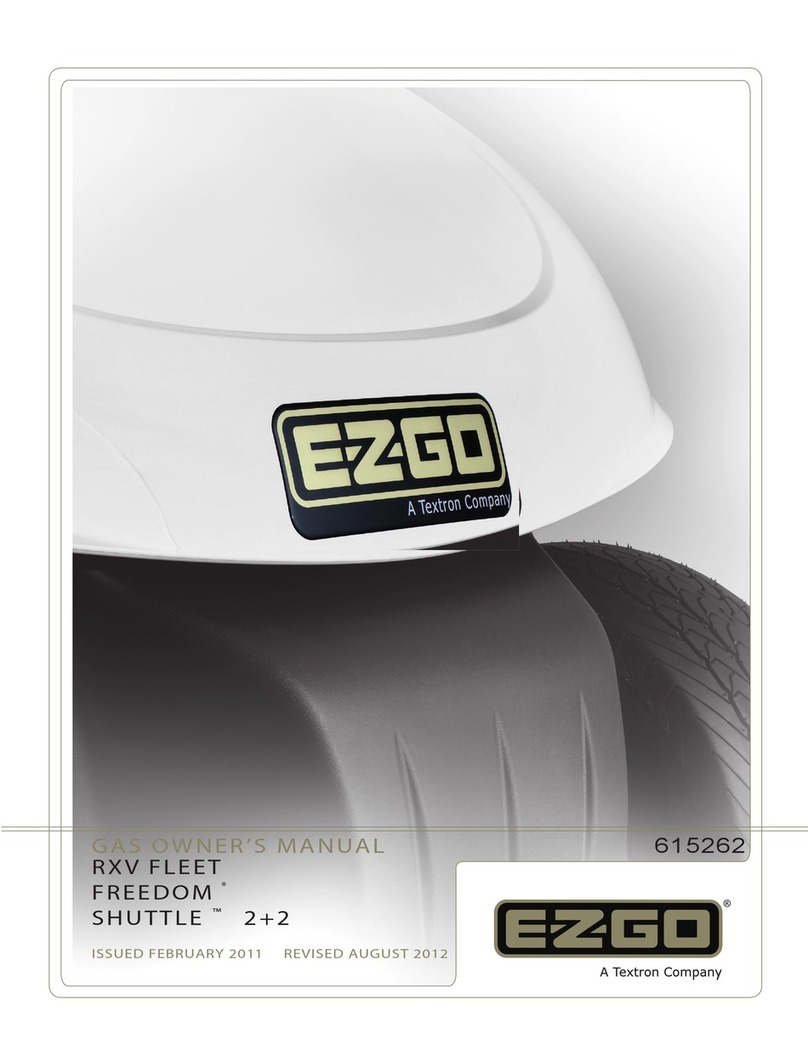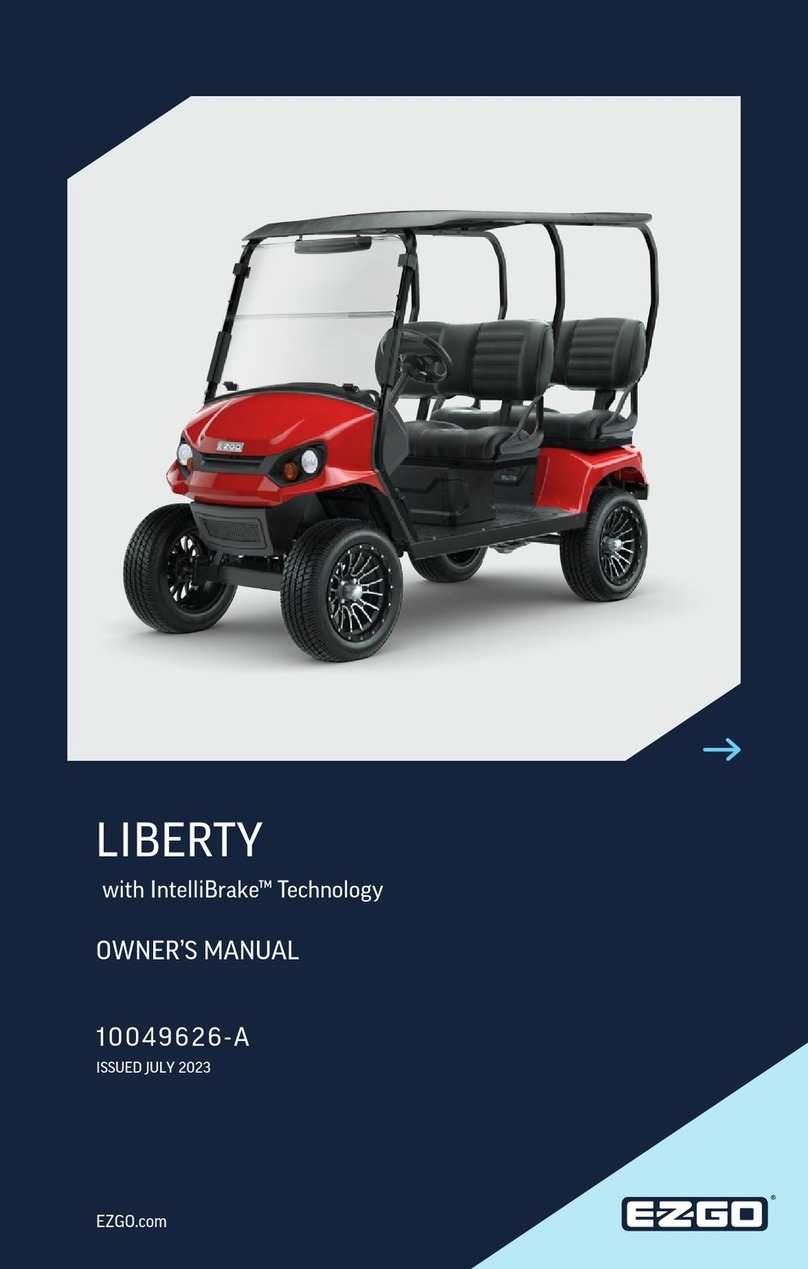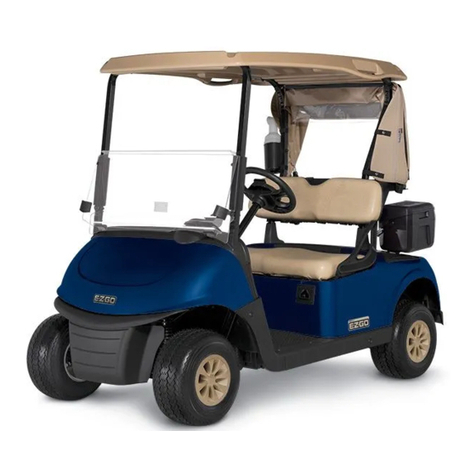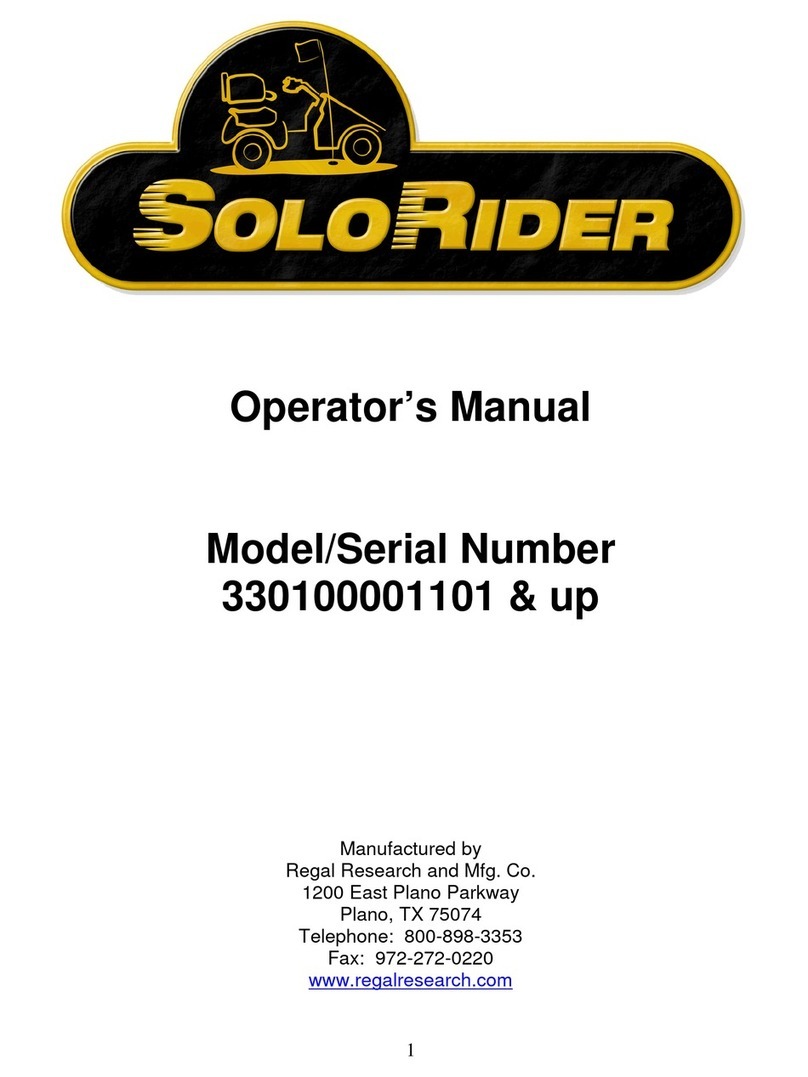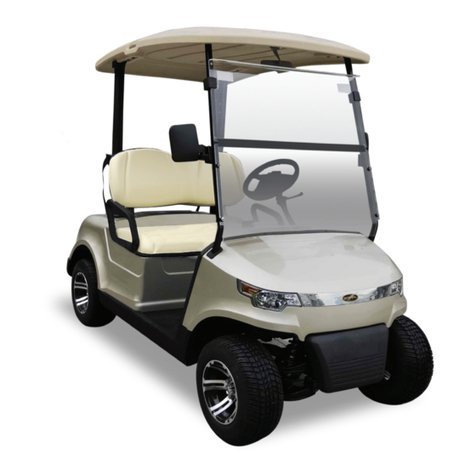Star EV AP48-04 User manual

Owner’s Manual and Service Guide
AP Series:
AP48-04, AP48-04-D, AP48-06, AP48-06-D

2
Thanks for buying the Star EV AP-Series. For better use, please read
through this manual before operating this vehicle to avoid any possi-
ble damage due to improper operation. Keep the manual handy aer
reading for future reference.
If you have any questions about the operation or maintenance of
your vehicle, please consult your Star EV dealer.
Important Information:
Important information is showed in following way in this manual:
WARNING: Failure to follow Warning instructions could result in se-
vere injury or death to the vehicle occupants, bystanders or persons
inspecting or repairing the vehicle.
CAUTION: Failure to follow Caution instructions could cause damage
to the vehicle.
Note: Remove the seat and backrest wrapping film to prevent seat vi-
nyl fading. If you have to stock the vehicle for long time, also remove
the seat and backrest wrapping film.

3
Vehicle Specifications
Operation
Important Labels
Functions
Operational Process
Charging Batteries
Safety
Maintenance
Battery
Cleaning
Recharging
Watering
Specific Gravity Test
Open-Circuit Voltage Test
Installation
Gear Box
Traction/Motor
Troubleshooting
Speed Controller
Brake System
Lubrication
General Maintenance Notes
Periodical Maintenance
Storage
Troubleshooting
Electric Wiring
Table of Contents
4
5
5
7
8
14
9
9
10
11
12
13
13
14
14
14
15
15
15
15
16
18
19
22

4
1: Vehicle Specifications
AP-Series 4-Passenger AP48-04, AP48-04-D
Passengers 4Body Material Fiberglass
Battery System Eight 6 V (48 V) batteries,
Trojan T-105 Front Suspension Independent, coil over shock
Motor Power 7 hp AC motor Rear Suspension Leaf spring and shock
Controller Power 450 A Curtis AC controller Steering System Rack and pinion
Top Speed 19.5 mph (20-25 mph if street
legal) Brake System Four-wheel hydraulic drum
brake
Load Capacity 780 lbs Tire Size 23x8.5-12 All-terrain tire
Dimensions 122” x 59” x 77” (L x W x H) Tire Pressure 14 psi
Weight w/ Batteries 1780 lbs no doors, 1885 lbs
with doors Wheel Type 12” aluminum
Ground Clearance 5” Roof Aluminum frame with fiber-
glass
Turning Radius 14.7 Windshield AS1, DOT automotive wind-
shield
Wheel Base 88” Drive Train Direct rear drive
Top Climbing Grade 20% Voltage Reducer 30 A, 48 V to 12 V reducer
included
Warranty Two year bumper-to-bumper warranty (less wear items)
AP-Series 6-Passenger AP48-06, AP48-06-D
Passengers 6Body Material Fiberglass
Battery System Eight 6 V (48 V) batteries,
Trojan T-105 Front Suspension Independent, coil over shock
Motor Power 7 hp AC motor Rear Suspension Leaf spring and shock
Controller Power 450 A Curtis AC controller Steering System Rack and pinion
Top Speed 19.5 mph (20-25 mph if street
legal) Brake System Four-wheel hydraulic drum
brake
Load Capacity 990 lbs Tire Size 23x8.5-12 All-terrain tire
Dimensions 153” x 59” x 77” (L x W x H) Tire Pressure 14 psi
Weight w/ Batteries 1905 lbs no doors, 2244 lbs
with doors Wheel Type 12” aluminum
Ground Clearance 5” Roof Aluminum frame with fiber-
glass
Turning Radius 19.8 Windshield AS1, DOT automotive wind-
shield
Wheel Base 118” Drive Train Direct rear drive
Top Climbing Grade 20% Voltage Reducer 30 A, 48 V to 12 V reducer
included
Warranty Two year bumper-to-bumper warranty (less wear items)

5
2: Operation
Important Labels
Please read the following labels carefully before operating the vehicle, and
promptly replace any labels which become unreadable or removed.
• Security Warning label under the dashboard
• Warning label under the dashboard
• Warning label beside the parking brake handle
Functions

6
Power key: Controls the power supply of the whole vehicle. When the key is insert-
ed into it and turned clockwise, it will switch on the lights, horn, and the control
system; when the key is turned back, the power will be switched o.
Acceleration pedal: Controls the speed. It should be depressed slowly. The vehicle
speeds up with the gradual stepping-down, and reaches the full speed when the
pedal is stepped to the bottom. The vehicle slows down when the pedal is released
gradually. When the pedal is fully released, electric brake works.
Brake pedal: Decelerates the vehicle.
F/R switch: This switch is a three-position button. Depressing the upper part (F)
makes the vehicle move forwards while depressing the lower part (R) makes the
vehicle move backwards, and the middle is neutral. NOTE: The buzzer will sound
when the lower part of this button is depressed to give warning to the people
around your electric vehicle.

7
Hand-brake lever: Parks and brakes the vehicle.
Steering wheel: Controls the driving direction.
Headlight switch: Controls the headlight.
Direction light switch: Controls the turning signal.
Wiper and horn switch: Controls the wiper and horn.
Emergency stop switch: Stops the power of the whole vehicle in case of emergen-
cy. NOTE: Before you switch on the vehicle, always check the status of this switch
to make sure that it is in the OFF position.
Digital display: This meter shows information including lights, speed, range, hand
brake, and battery power.
Operational Process
Starting the vehicle
1. Select F for Forward or R for Reverse from F/R button.
2. Switch on power with key.
3. Release the handbrake lever.
4. Depress the acceleration pedal smoothly.
WARNING: If you switch on power key first before selecting Forward or Reverse on
F/R Button, the vehicle will not run.
Stopping the vehicle
1. Step brake pedal to decelerate the vehicle until it stops completely and
shi F/R button to neutral position.

8
2. Engage the handbrake lever to park the vehicle.
3. Release the service brake.
4. Switch o all lights.
5. Switch o the power key and take out the key.
Charging Batteries
• CAUTION: There are two dierent kinds of chargers for this vehicle. One
is an exterior charger and the other is a built-in (on-body) charger. Before
you use the charger, read the charger operation manual.
• Explosive hydrogen gas is produced while battery is charged. Only charge
the battery in well-ventilated areas.
• Before using the charger, check if the battery charger you are using is
correctly rated for your local AC electricity network.
• Do not disconnect the DC output cord from the battery receptacle when the
charger is ON, otherwise an arc could occur which may cause an explosion.
• Do not open the housing of the charger. Only a qualified electrician should
open the housing of the charger.
• The charger should be stored in safe and dry room with good ventilation.
The charger should be packed properly if not used for long time.
Charging Procedure
Turn o the power of the vehicle before charging.
For a exterior charger with one set of batteries:
1. Connect charger to DC receptacle on the vehicle.
2. Connect the charger to AC power.
3. Turn on the charger.
4. Turn o the charger when the batteries are fully charged. Disconnect the
charger from AC power first, and then disconnect the charger with AC
receptacle.
For on-board (built-in) charger:
1. Connect the charger with AC power.
2. Turn on the charger.
3. Turn o the charger when the batteries are fully charged, disconnect the
charger with AC power.

9
3: Safety
The driver should have a good knowledge of the operation system of the vehicle
and its features while following rules for safe operation.
WARNING: Drive the vehicle o streets unless it is allowed.
• The vehicle cannot be overloaded, or the motor will be damaged. An
overloaded vehicle can lose control and its life will be shortened.
• Unqualified persons are prohibited to drive the vehicle.
• Make sure this vehicle runs in its rated climbing ability.
• Don’t overtake other vehicles at crossroads, in blind areas or in other
dangerous zones.
• Keep your entire body inside the vehicle, keep seated and holding on while
the vehicle is moving.
• Do not start the vehicle until all occupants are securely seated.
• Keep your hands on the steering wheel and your eyes on the path ahead.
• Always back out the vehicle slowly and watch the back carefully.
• Avoid starting and stopping suddenly.
• Avoid turning the vehicle too sharply at high speeds.
• Always drive slowly up and down slopes.
• Do not make any modification or addition which may aect the capacity
or safety.
• Do not allow children to play in the vehicle. Children should be seated
between adults and protected while the vehicle is moving.
4: Maintenance
WARNING: Battery electrolyte is poisonous and dangerous, may cause severe
burns, injury, etc. Always wear protective clothing, gloves, and goggles when
handling batteries, electrolyte, and charging your battery.
KEEP OUT OF REACH OF CHILDREN.
Battery Maintenance
Cleaning
The exterior of the battery, the connection wires and bolts should always be kept
clean and dry. When cleaning, make sure all vent caps are tightly in place. Clean

10
the battery top with a cloth or brush and solution of baking soda and water. When
cleaning, do not allow any cleaning solution or other foreign matter to get inside
the battery. This should be done every week.
Clean battery terminals and the inside of cable clamps using a post and clamp
cleaner. Clean terminals will have a bright metallic shine. This should be done
whenever necessary.
Reconnect the clamps to the terminals and thinly coat them with petroleum jelly
(Vaseline) to prevent corrosion.
WARNING: Before you disconnect any battery cable from any terminal on the
battery, always remove the power by disconnecting the main battery cable from
the controller.
Checking the terminals and nuts: The connection of the battery should always be
kept in good condition. Check every week on whether any battery cable terminal
or nut has become loose in order to prevent any damage to terminals. Check the
status of the battery cable weekly. A damaged battery cable should be replaced
immediately.
Foreign matter: Do not place any objects on the battery and do not connect the
positive pole to the negative pole. This may cause a short circuit and sparking.
Recharging
• As long as you use the vehicle, regardless of how long you have used it,
the battery should be recharged fully on the same day. Any delay in re-
charging will negatively aect the battery. The lead-acid battery does not
develop a memory, so need not be fully discharged before recharging.
• If the vehicle is going to be kept unused for a long time, the battery should
be fully recharged first. Aer that, the battery should be fully recharged
every two weeks.
• When driving, the driver should always be aware of the drop level of the
battery power from the battery power meter. Any drop means the battery
power is diminishing. The driver can estimate the distance needed to be
taken, and recharge the battery at a proper time in case the vehicle cannot
get back to the recharging station in time for recharging.
WARNING: Make sure the battery is recharged before the battery power meter
shows 20% power is le inside the battery. An over-discharged battery will have a
very short service life and will make recharging diicult.
WARNING: During recharge, the vehicle should be parked in a well-ventilated area

11
with the fill caps tightly secured. Keep far away from any flame and sparks to avoid
any explosion or fire that could cause physical injury or damage to the property.
During recharge, if the vehicle had doors, keep the doors open. Li the seat bottom
to keep the battery compartment open to the air.
Watering
Flooded batteries need water. More importantly, watering must be done at the
right time and in the right amount or else the battery’s performance and longevity
suers. Water should always be added aer fully charging the battery. Prior to
charging, there should be enough water to cover the plates. If the battery has
been discharged partially or fully, the water level should also be above the plates.
Keeping the water at the correct level aer a full charge will prevent having to worry
about the water level at a dierent state of charge.
It is recommended that batteries be checked once a month until you get a feel for
how oen you must water your batteries. Important things to remember:
• Do not let the plates get exposed to air. This will damage (corrode) the
plates.
• Do not fill past the water level in the filling well to the cap. This most likely
will cause the battery to overflow acid, consequently losing capacity and
causing a corrosion.
• Do not use water with a high mineral content. Use distilled or de-ionized
water only.
WARNING: The electrolyte is a solution of acid and water so skin contact should be
avoided.
Watering procedure
1. Open the vent caps and look inside the fill wells.
2. Check electrolyte level; the minimum level is at the top of the plates.
3. If necessary add just enough water to cover the plates at this time.
4. Put batteries on a complete charge before adding any additional water
(refer to the Charging section).
5. Once charging is completed, open the vent caps and look inside the fill
wells.
6. Add water until the electrolyte level is 1/8” below the bottom of the fill
well.
7. A piece of rubber can be used safely to help determine the level.
8. Clean, replace, and tighten all vent caps.
CAUTION: Never add acid to a battery.

12
Testing: Visual inspection alone is not suicient to determine the overall health of
the battery. Both open-circuit voltage and specific gravity readings can give a good
indication of the battery’s charge level, age, and health. Routine voltage and gravity
checks will not only show the state of charge but also help spot signs of improper
maintenance, such as undercharging and over-watering, and possibly even locate
a bad or weak battery. The following steps outline how to properly perform routine
voltage and specific gravity testing on batteries.
Specific Gravity Test (Flooded batteries only)
1. Do not add water at this time.
2. Fill and drain the hydrometer 2 to 4 times before pulling out a sample.
3. There should be enough sample electrolyte in the hydrometer to
completely support the float.
4. Take a reading, record it, and return the electrolyte back to the cell.
5. To check another cell, repeat the 3 steps above.
6. Check all cells in the battery.
7. Replace the vent caps and wipe o any electrolyte that might have been
spilled.
8. Correct the readings to 80° F:
a. Add .004 to readings for every 10° above 80° F.
b. Subtract .004 for every 10° below 80° F.
9. Compare the readings.
10. Check the state of charge using the table below.
The readings should be at or above the factory specification of 1.277 +/- .007. If any
specific gravity readings register low, then follow the steps below.
1. Check and record voltage level(s).
2. Put battery/batteries on a complete charge.
3. Take specific gravity readings again.
If any specific gravity reading still registers lower than the factory specification of
1.277+/- .007 then one or more of the following conditions may exist:
1. The battery is old and approaching the end of its life.
2. The battery was le in a state of discharge too long.
3. Electrolyte was lost due to spillage or overflow.
4. A weak or bad cell is developing.
5. Battery was watered excessively previous to testing.
6. Batteries in conditions 1 - 4 should be taken to a specialist for further
evaluation or retired from service.

13
Open-Circuit Voltage Test
For accurate voltage readings, batteries must remain idle (no charging, no
discharging) for at least 6 hrs, preferably 24 hrs.
1. Disconnect all loads from the batteries.
2. Measure the voltage using a DC voltmeter.
3. Check the state of charge with the table below.
4. Charge the battery if it registers 0% to 70% charged.
If battery registers below the Table 1 values, the following conditions may exist:
• The battery was le in a state of discharge too long.
• The battery has a bad cell.
These batteries should be taken to a specialist for further evaluation or retired from
service.
State of charge as related to specific gravity and open circuit voltage
Percentage of
Charge
Specific Gravity
Corrected to
80°F
Open-Circuit Voltage
6 V 8 V 12 V 24 V 36 V 48 V
100% 1.277 6.37 8.49 12.73 25.46 38.20 50.93
90% 1.248 6.31 8.41 12.62 25.24 37.85 50.47
80% 1.238 6.25 8.33 12.50 25.00 37.49 49.99
70% 1.217 6.19 8.25 12.37 24.74 37.12 49.49
60% 1.195 6.12 8.16 12.24 24.48 36.72 48.96
50% 1.172 6.05 8.07 12.10 24.20 36.31 48.41
40% 1.148 5.98 7.97 11.96 23.92 35.87 47.83
30% 1.124 5.91 7.88 11.81 23.63 35.44 47.26
20% 1.098 5.83 7.77 11.66 23.32 34.97 46.63
10% 1.073 5.75 7.67 11.51 23.02 34.52 46.03
Installation
Tighten the battery cables to battery terminals with torque of 95 - 105 lbs. in. (10.7
- 11.9 N.M.) Make sure there is nothing else between the battery cable lug and
battery terminal post.
WARNING: When working with the battery, DO NOT put wrenches or any other
metal objects across the battery terminals, otherwise, an arc can occur, and it may
cause explosion of the battery and physical injury.
Battery should be installed or replaced only by a qualified electrician.

14
Gear Box Maintenance
• The clearance for the clutch should be kept at 2 – 3 mm.
• The friction plate should be changed periodically; the friction value on one
side should not exceed 2 mm.
• Adjust the flatness of the platen spring plate (feeling manually). First,
tighten the screws diagonally, using your hand to check the flatness of the
spring plate. If not flat, tighten the screws.
• Change the gear oil inside the gear box periodically. For a new vehicle,
change the oil aer one month or accumulated running distance exceeding
750 miles; change the oil again two months later, then change the oil every
six months. The oil type is 85W/90GL.
• Clean the gear box before changing the oil.
• CAUTION: Never mix dierent oils.
Traction/Motor Maintenance
• The motor is designed for use up to 4000 feet above sea level and in a
temperature between -15° F and 105° F.
• Never keep the motor running idly. Any mud, sand, and other clinging
objects should be cleaned away.
• Check the carbon brush every three months. To change a worn or
weakened carbon brush, press spring.
Troubleshooting for Motor
Warning: Only a qualified electrician should change and adjust the carbon brush.
Symptoms Possible Causes
All copper plates turn black The pressure of brush is incorrect.
The commutator turns black in a
certain order and in groups
Short circuit in the commutator or armature coil; poor welding or discon-
nection between the commutators and the armature coil.
The commutator turns black The central line of the commutator deviates or its surface is not round
and smooth.
The brush wears out, turns colors
and becomes broken
The motor vibrates; the clearance between the brush and its holder is
too big; the clearance between the brush and commutators is too big;
the brush is made by wrong materials; the brush is the wrong type.
Sparks
The motor is overloaded; the commutators are not clean, round or
smooth; mica or some commutators extrude; the brush is not ground
properly; the brush is the wrong type; the brush is jammed in the brush
holder; the brush holder become loose or vibrating; the polarity and
sequence of magnetic poles is wrong.
The brush and its wires get hot Big sparks of the brush; poor contact between brush and so wires.
The brush is noisy The surface of the commutators is not smooth.

15
Speed Controller Maintenance
• The speed controller of the vehicle is wholly imported, which adopts high
frequency MOS technology to realize the control of speed, torque and
brake with smoothness, silence, and high energy eiciency.
• When the vehicle starts, the controller will inspect signals from the
accelerator. If signal exceeds 20%, the HPD (protection unit in the
controller) will prohibit the output of the controller.
• The controller will self-check when the vehicle is running. If any defect
inspected, the controller will stop the vehicle to protect the operator and
the vehicle.
Brake System Maintenance
• Depress the brake pedal with a force of 65 lbs. The pedal travel shouldn’t
exceed 2/3 of the full free pedal travel.
• The clearance for the brake plate is self-adjusted. Under a force of around
45 lbs, the parking brake handle should be fixed in one gear from 5 to 10
ratchets. When the brake handle is released completely, the brake function
will stop.
• Inspect and change brake shoe, and add lubrication into the brake bearing
periodically.
Lubrication
• Use 901 vehicle brake oil DOT3 as brake oil. Use 1L of 85W/90GL lubrication
oil for gear box. Use 1L of 90GL hypoid gear oil for the rear axle.
• Lubrication points: steering gears, horizontal bars, steering ball joints, and
bearings.
General Maintenance Notes
• To avoid any damage on the brake shoe, the handbrake should be released
to its bottom before staring the vehicle.
• The lubricant for rear power assembly must be applied and changed as
per user’s manual.
• The brake system must be adjusted once every 3 months.
• The electricity system must be checked once every 3 months (especially
main circuit) for its fastening parts and wiring connections. Meanwhile

16
the contactor should be checked. Any defective parts should be replaced
immediately. Dust should be cleaned with low pressure air.
• The electric contactors easily become hot if their mutual contact is not
in good condition, so special attention should be paid regularly to the
electric contactors.
• When changing a fuse, make sure that the new fuse is right in rated current.
• Disconnect the positive pole from the battery when maintenance is done.
• Never step the accelerator hard and frequently, which may shorten the life
of the controller.
• It is prohibited to pour any other liquids (such as battery additives,
mineral water and tap water) into the battery. Only distilled water should
fill battery.
Periodical Maintenance
• Check if the contact between contacting points of the contactor is in good
condition, check for any mechanical sticking or jamming.
• Check if the micro switch in the accelerator can be switched on and o
properly.
• Check if the switch for the turn signal can be switched on and o properly.
• Check if all the connections between the motor, the battery, and the
controller are in good condition.
Use the following cleaning procedure for routine maintenance:
1. Turn the power key to OFF position.
2. Remove power by disconnecting the battery.
3. Discharge the capacitors in the controller by connecting a load (such as a
contactor coil or a horn) across the controller’s B+ and B- terminals.
4. Remove any dirt or corrosion from the connector areas. The controller
should be wiped clean with moist rag. Dry it before reconnecting the
battery. The controller should not be subjected to pressured water flow
from either a standard hose or a power washer.
5. Make sure the connections are tight, but do not over-tighten them.
NOTE: All above checks should be performed with the power o. Above checks
shall be carried out once every 3 months; aer the power is turned o, the wave-
filter capacitor in the controller unit should continue discharging for a few minutes
more; don’t wash the electrical parts with water. You can remove dust with a brush
or high–pressure air.

17
Periodical Maintenance Chart
Regular maintenance is required for the best performance and safe operation of
the vehicle.
WARNING: Make sure to turn o the power key and apply the park brake when
you do the maintenance unless specified. If the owner is not familiar with the
maintenance of this vehicle, the dealer should do the work.
Item Description Daily Weekly Monthly Quarterly Yearly
Battery
Check the liquid level. Add dis-
tilled water if necessary. ☑
Charge the battery. ☑
Tighten the nut on the battery
cable. ☑
Check if the battery is over-dis-
charged (the battery power
meter flashing). ☑
Check the liquid density of the
battery; standard density should
be 1.275±0.005. ☑
Check if the battery is charged
fully by using the hydrometer
and checking the battery power
meter.
☑
Clean the surface of battery. ☑
Charger
Observe the charging status,
check if the charger plug be-
comes hot. ☑
Clean the surface of the charger.
Do not get any water inside the
charger. ☑
Controller
Check if all terminals are tight-
ened properly. Do this aer the
power is o. ☑
Clean the surface of the con-
troller. ☑
Check if the solenoid is in order,
checking its touching point. ☑
Motor
Check if any water gets in. Check
if it becomes too hot. ☑
Check if the carbon brush should
be replaced. ☑
Check if the accelerator pedal
works well and if it can be re-
leased freely and automatically. ☑

18
Periodical Maintenance Chart, continued
Item Description Daily Weekly Monthly Quarterly Yearly
Chassis and
body
Check if the brake drum and the
brake shoe should be replaced. ☑
Check if the hand brake func-
tions. ☑
Check if the hose and tube for the
brake liquid leaking. ☑
Check if the brake liquid inside
the brake liquid tank is enough. ☑
Check the air pressure inside the
tire, check if the tire surface is
worn, and check if the nuts are
tightened properly.
☑
Check if the shock absorber has
any oil leaking, flat or abnormal
noise. ☑
Check if there is oil leaking on the
gear box and the rear end. ☑
Add the lubricant inside the
wheel hub, steering system. ☑
Adjust the toe-in of the front end. ☑
Clean the body and seat. ☑
5: Storage
Follow the steps below when the vehicle is stored.
1. Check the liquid level inside the battery; recharge it fully before storing the
vehicle. WARNING: Charge the battery once a month if your vehicle will be
stored more than one month.
2. Turn the power key to OFF position, remove the key, and store the key in
a safe place.
3. Engage the handbrake.
4. Check the tire pressure to make sure its pressure is set to recommended
pressure.
5. Clean the exterior of the vehicle and apply a rust inhibitor.
6. Cover the vehicle with a breathable cover and store it in a dry, safe, and
well-ventilated place.
7. If you plan to store the vehicle for a longer time, check the liquid level
inside the battery and recharge the battery monthly.

19
6: Troubleshooting
There is no settled mode to diagnose and eliminate malfunctions. During
maintaining and checking, we suggest you first listen, then look and feel. Below is
the diagnoses and maintenance of some common malfunctions.
1. The vehicle doesn’t move
Malfunction Possible Reason Troubleshooting
Turn on power key; no
display on instrument
panel
Connector(s) in circuit is loose or open Tighten or connect
Fuse of controller or main circuit is open Change fuse
Battery cable(s) is loose or disconnected Tighten or change
Power key is broken Change
Voltmeter is broken Change
Battery terminals connect improperly Adjust
Turn on power key; in-
strument panel displays
signs
Improper operating procedure Operate properly
Controller failure Check or change
Solenoid failure Check, repair, change
Accelerator failure Repair or change
Motor failure Repair or change
Parking brake doesn’t loosen Loosen parking brake
Over-heat protection Check, eliminate
Malfunction Possible Reason Troubleshooting
Vehicle runs at full speed
when it starts
Terminals of solenoid stick together Check or repair
Controller failure Change
Potentiometer failure Repair or change
Vehicle stops immedi-
ately aer it starts
Internal short of motor Repair or change
Motor is assembled too tight or blocked Repair or change
Controller failure Repair or change
Accelerator failure Repair or change
Normal power at low
speed, weak power at
high speed
Controller failure Check or repair
Motor failure Check or repair
Accelerator failure Check or repair
2. Locking control when vehicle starts funning, speed cannot be adjusted
3. Vehicle cannot change direction, only runs in one direction
Malfunction Possible Reason Troubleshooting
Vehicle can only run in
one direction
F&R switch failure Change
Controller failure Change

System Malfunction Possible Reason Troubleshooting
Transmission
system
Abnormal sound when
running
Clearance of rear axle decelerating gear is
too big, or the decelerating gear is broken Adjust, change
Transmission cross sha is worn out Change
Gear of transmission is worn out or
damaged Change
Flange bearing is damaged Change
Motor bearing is damaged Change
Gear liquid is deficient or empty Add gear liquid
Hard to shi gear, or gear
shi jumps to dierent
positions
Clutch cannot separate smoothly Adjust
Gear shi wire is damaged Change
Gear inside transmission case is worn out Change
Orientation pin is loose Change
Steering
system Steering heavy
Pressure of front tire is deficient Check the pressure
and inflate
Screw plug of redirector is too tight Adjust
Lack of lube in redirector Maintain/add lube
Toe-in is abnormal Adjust
Clearance of tension rod ball is too big Change
Steering knuckle and master pin is not
lubricated Add lube
Steering sha or its plastic cover is worn
out Change
Steering
system Unstable wheels
Rack of redirector is worn out Change redirector
Screw plug of redirector is too tight Adjust
Toe-in is adjusted improperly Adjust
Bearing of front wheel is worn out Change
Tie rod ball and joint is worn out Change tie rod
Redirector is loose Tighten
Driving
system
Deflected running
The pressure of the two front tires is
dierent Inflate
Toe-in is too big or too small Adjust
Tightness of the le and right drum bear-
ing of front wheels is dierent Adjust
Brake of one wheel is too tight Adjust of change
Spring shock absorber is abnormal Change
Front suspension is loose Change
Abnormal tire fray
Tire pressure in abnormal Inflate
Toe-in is improper Adjust
Drum bearing loose Change
U type bolt of leaf spring is loose Tighten
Rim is distorted or frame is distorted Tighten
Brake force of each wheel is dierent Adjust
Overexerting accelerator or braking
frequently Alter operation
4. Possible reason and troubleshooting for other malfunctions
This manual suits for next models
3
Table of contents
Other Star EV Golf Car manuals
Popular Golf Car manuals by other brands
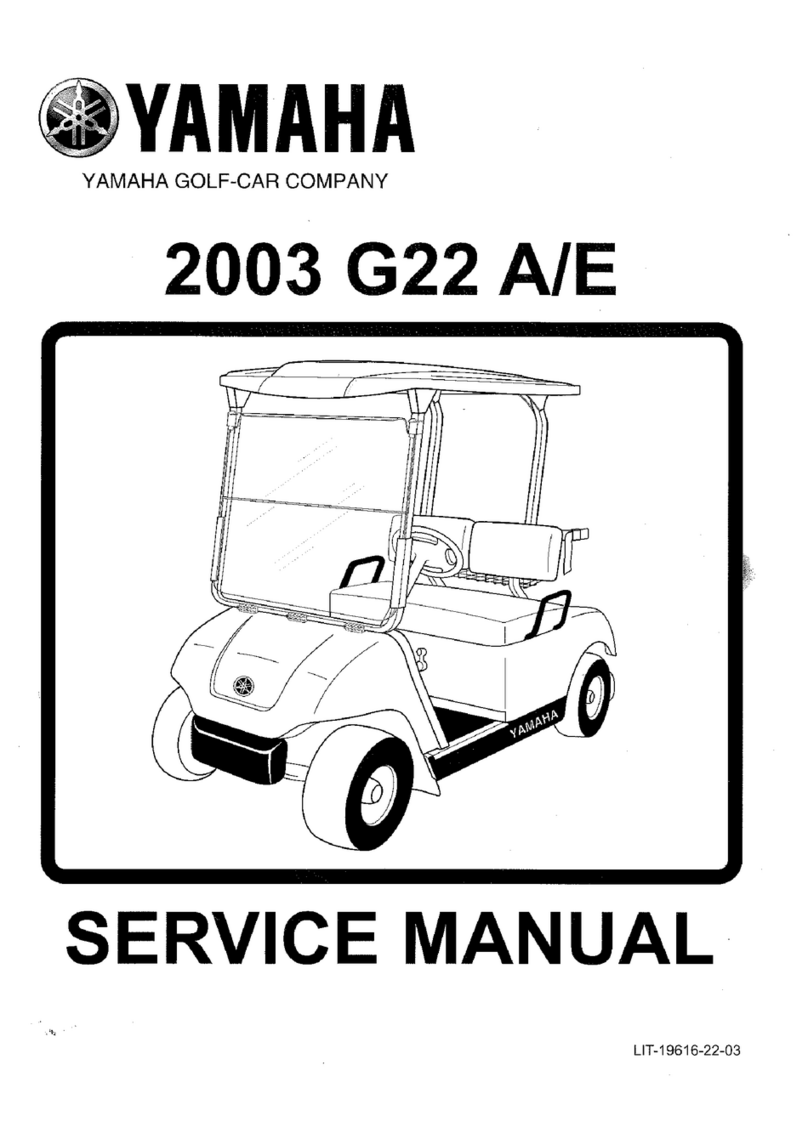
Yamaha
Yamaha G22 A/E Service manual
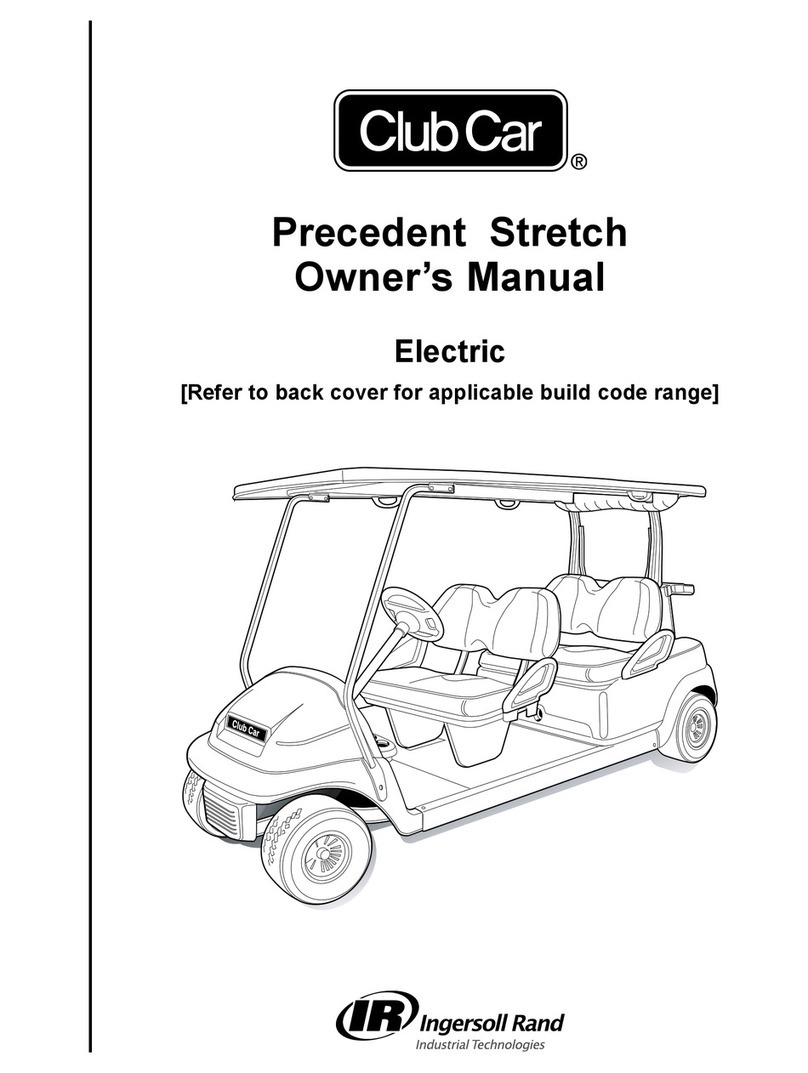
Club Car
Club Car Precedent Stretch owner's manual
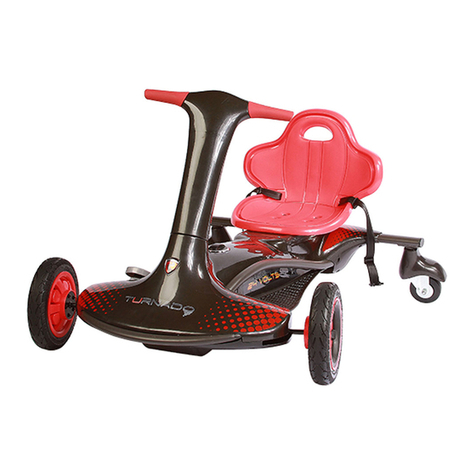
Rollplay
Rollplay 24V TURNADO W401-OB Owner's manual and assembly instructions
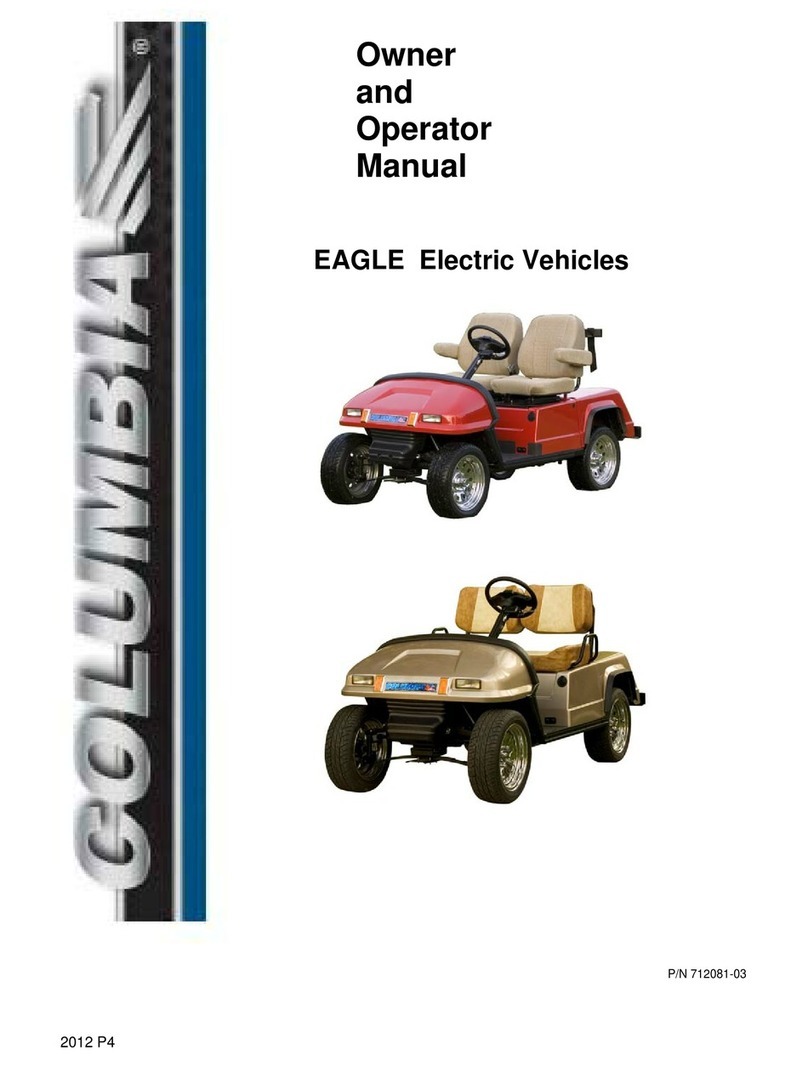
Columbia ParCar
Columbia ParCar Eagle Owner's and operator's manual
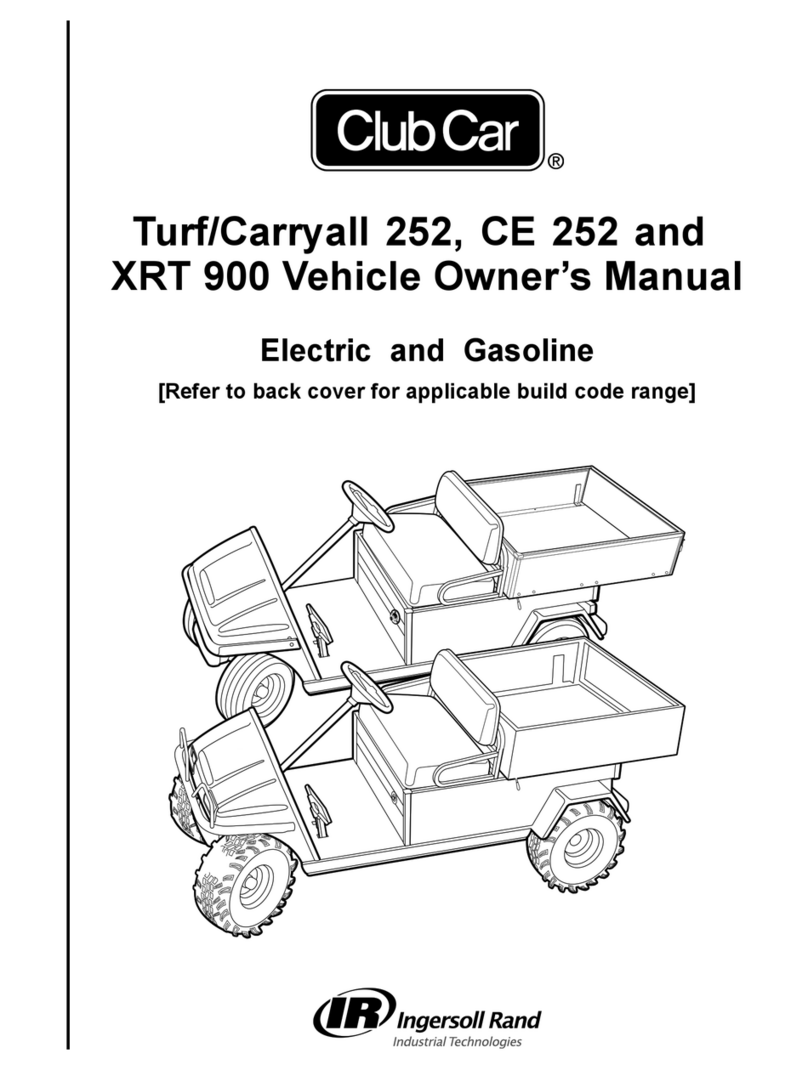
Ingersoll-Rand
Ingersoll-Rand Club Car Turf 252 owner's manual
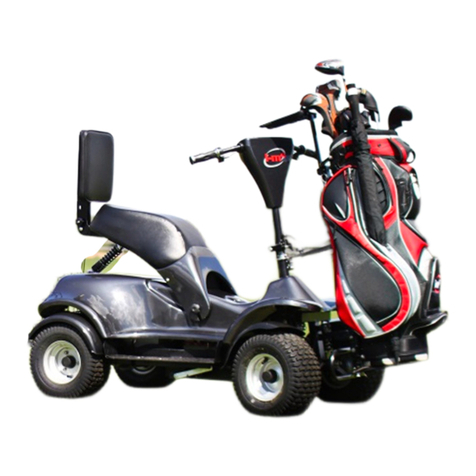
I-Motioncaddys
I-Motioncaddys IM4 owner's manual
